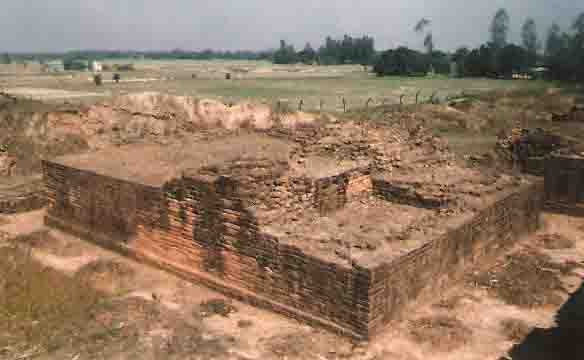| The Telegraph - Metro on Sunday 15th July 2007.
Next weekend you can be at ... Nandadirghi Vihar
Twenty years ago, residents of Jagjivanpur, a nondescript village on the eastern fringes of the Malda district, adjacent to the India-Bangladesh border, had stumbled upon a copper plate of great historical importance. Measuring 52.5cm x 37.5cm, the plate, with a royal seal on top, contains inscription on both sides in a forgotten ancient script.
Through the charter, a hitherto unknown ruler called Mahendrapal Deva, of the Pala dynasty, bequeathed a plot called Nandadirghik-odranga to his army chief Mahasenapati Vajradeva for building a Buddhist monastery to help his parents and the people in general attain religious merit.
The plate, prepared at a place called Kuddalakhataka, describes Mahendrapala as the son of Devapala. He ruled over region in the 9th Century AD. The plate helped historians to re-write the political history of Bengal and north India.
The discovery led to extensive excavation of the Jagjivanpur area. Five mounds were dug up at Tulabhita, Akhridanga, Nimadanga, Maibhita and Lakshmidhibi. Of these, Tulabhita is the biggest and most impressive and was excavated first. The exploration revealed a structure containing a sanctum sanctorum, bastions-cum-cells, balcony, steps, bathroom complex, well, courtyard and entrance. The archaeological findings suggest that the ruins were the remains of Nandadirghi Vihar, one of the leading centres of learning in 9th Century AD.
About 350km from Calcutta, Nandadirghi Vihar can be an ideal weekend getaway and can be clubbed with visits to the more famous historical sites at Gour and Pundooah. For the most comfortable journey, take the night train to Malda town. After breakfast, rent a car and head for Jagjivanpur. A bumpy ride of an hour and a quarter will take you to the gateway of the ruins.
The 30m x 30m structure, maintained by the state archaeological department, is enclosed by a barbed wire. The four corners of the square structure had four circular constructions, two of which exist to this day. Beautiful terracotta panels adorned the four walls. The panels have been removed to State Archaeological Museum in Behala, Calcutta. The structure has a courtyard in the middle, surrounded on all sides by two lines of square identical cells, which were probably used as students’ residence or classrooms.
The sanctum sanctorum lies on the western side, behind the cells. The northern side contains the bathroom with an elaborate drainage system. The entrance, well, balcony and several flights of stairs add a special dimension to the ancient structure.
The trip will take you back to the pages of forgotten history and provide an experience that no book can provide.
(Metro on Sunday thanks reader RANGAN DATTA for this contribution. Picture by author)
Going :Gour Express, Intercity Express and Jan Satabdi Express connect Malda town with Sealdah / Howrah. The bus service between Malda town and Jagjivanpur is infrequent, so it is best to rent a car. For a round trip of 82km, the fare is approximately Rs 550.
Staying :There are no eateries in Jagjivanpur, so have your food at Malda town, which also has several lodges for night halt. There are restrictions on taking pictures. It is best to obtain a permit from State Archaeological Museum in Behala. |

